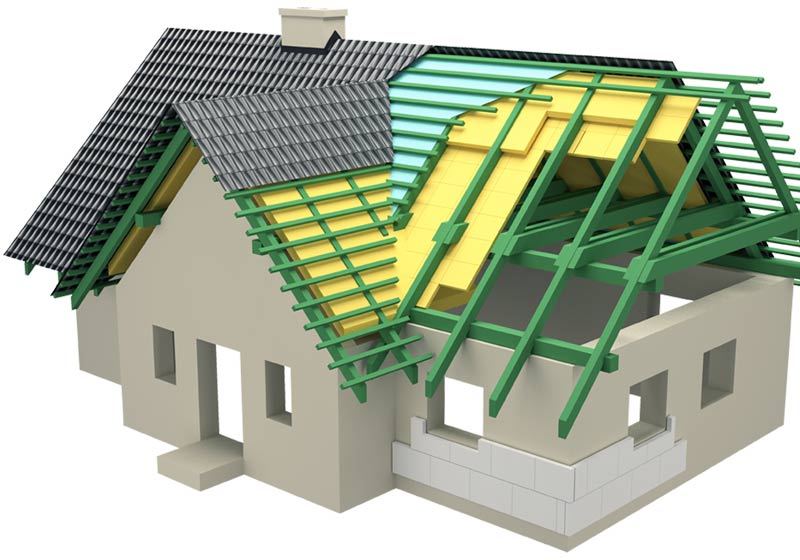Radiant Barrier Insulation Services
Call Us Today- Home
- »
- Radiant Barrier
Many homeowners choose to have radiant barriers installed to further help improve their home’s energy efficiency. If you have enough insulation but want to do something more, then you may also benefit from radiant barriers. At Action 1 Insulation, we’ve seen how beneficial this can be, no matter the size home you have. We’d love to help you with this addition to your home, especially because it is so effective without having a high cost.
What is a Radiant Barrier?
A radiant barrier is made from aluminum, making it highly reflective. This property makes it excellent at reflecting the heat of the sun and blocking it from making its way into the rest of the home. However, in order for this material to have maximum efficiency, it must have at least 3/4 inch of air on either side of it. This requirement means a radiant barrier cannot be installed in certain areas, such as underneath roofing materials. Instead, it must be installed in areas where it will have open space on at least one side. In most cases, this means it’s an excellent option for underneath roof decking and on attic/garage walls.
Radiant Barrier Pros:
- Excellent for reducing heat in hot climates
- Prevents radiant heat
- Cannot grow mold
- Won’t deteriorate over time
Radiant Barrier Cons:
- Can get dirty/ Will need to be cleaned
- Not as useful in cold climates
Average Professional Labor Cost
The materials for radiant barriers can vary widely, from $0.10 to $1 per square foot. Installers will generally charge $30 to $80 on top of this, making the cost for a radiant barrier generally affordable. If you’re not sure if this is an investment that’s worthwhile, then we recommend talking with a contractor at Action 1 Insulation. They can look at your space to determine if a radiant barrier is appropriate, what type will perform best, and where it should be installed.
Best Material Types You Should Use
Single-Sided Foil
As the name states, this type of radiant barrier only has one side with reflective material. The other side is normally made with a solid color, like white, that is aesthetically more pleasing in appearance. If you want something that will look nice once installed, this is a good option to consider. The benefits of this are just the same as traditional radiant barriers, as the non-reflective side only impacts appearance. This can be installed anywhere radiant barriers will thrive, such as attics and garages.
Foil-Faced Roof Sheathing
With this material, the foil side is designed to face toward the air space in order to have maximum thermal benefits. When installed properly, this can provide an R-value of around 2, which makes it excellent for helping reduce heat throughout the house. Most homeowners choose to have this installed in their attic for the best efficiency possible. This is most useful in hotter climates with more sun, as colder areas generally won’t get much use out of the reflective properties this offers.
Double-Sided Foil
A double-sided radiant barrier is the top choice for many homeowners who want radiant heat reflected on both the top and bottom of the barrier. This can make it useful throughout the year rather than only during the hotter months when the sun is out the most. This is normally installed inside of an attic or garage since it will perform well in either of these environments.
Multi-Layered System
If you want better insulation with a radiant barrier, then multi-layer systems may be what you’re looking for. These are made with reflective foil barrier on one side and backings such as plastic film, polyethylene bubbles, carboard, thermal insulation, or Kraft paper on the other. This is normally used inside of attics, as long as there is enough air space on the reflective side to ensure it can be effective.
What is the Installation Process?
The installation process for radiant barriers is generally fairly simple, which is why many homeowners choose do the installation themselves. However, it’s important to make sure there is enough air space and the foil is facing the right way. If this is not installed properly, then you will not experience any of the benefits that radiant barriers have to offer. If you have the reflective side facing the right way, it can normally be installed with a staple gun and some time.

How Action 1 Insulation Can Help You
When you decide on a radiant barrier, it’s important to understand your options and how this material can benefit your home. To help, our team at Action 1 Insulation begins with an in-person inspection. With this, we can determine if a radiant barrier will be right for your home and which material is best. Once you make this decision, the installation process can begin. One of our contractors will take care of the details, including bringing the materials in for you.
Although installing a radiant barrier may seem simple, the process can be difficult. If you want help choosing the material and installing it properly, then we highly recommend having a contractor on your side. We will take care of the hard work while also keeping you involved in the process. This can reduce your stress, save you money, and ensure you get the results you want. Although this is a small home update, it’s one that should be done right with the help of one of our professionals.
